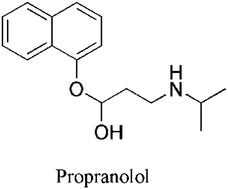Fluorescence suppression of MPA stabilized CdTe QDs for direct determination of propranolol
Abstract
A sensitive, convenient and rapid fluorescent sensor for effectively and directly detecting propranolol was proposed based on the fluorescence suppression of 3-mercaptopropionic acid stabilized CdTe quantum dots. The fluorescence suppression mechanism between CdTe QDs and propranolol was studied by time-resolved fluorescence spectroscopy, UV-Vis spectroscopy and fluorescence spectroscopy, and it was attributed to the simultaneous action of the inner filter effect (IFE) and dynamic quenching effect (DQE). The effects of the concentration of quantum dots, pH value of buffer solution and incubation time on the fluorescence signal of the propranolol/CdTe quantum dot system were also investigated. The results indicated that, when the experiment was conducted under optimal experimental conditions, the linear range of this assay was 0.1 μM to 2 μM and 5 μM to 200 μM, with a corresponding detection limit of 0.055 μM. Moreover, some common drug excipients and analogues of propranolol and stimulants had no apparent effect on the determination of propranolol. The proposed fluorescent sensor could be readily used for effectively and directly detecting propranolol in biological samples.



 Please wait while we load your content...
Please wait while we load your content...